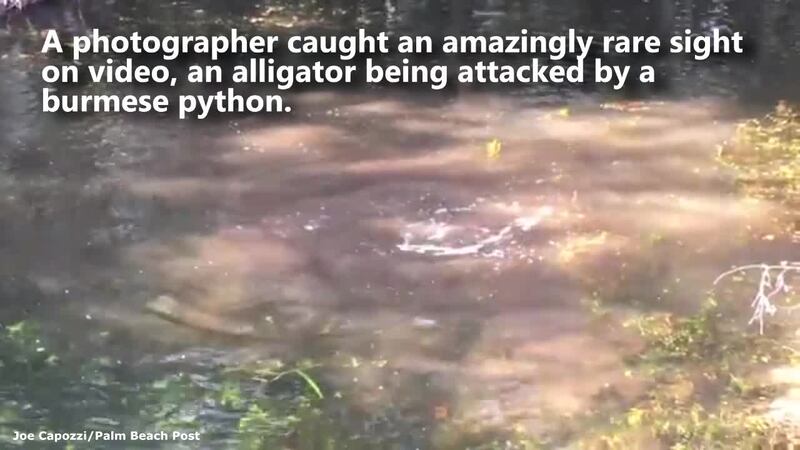OCHOPEE, Fla. — You hear a big splash in Big Cypress, chances are it’s an alligator diving into the swamp, most likely after being startled from a roadside sunbath by an approaching human.
But this was one big splash followed by another big splash. And another and another. I stopped my bicycle to see what all the ruckus was about.
Right there, just off the edge of Loop Road, no more than 15 feet away, an alligator was rising tail first and belly up over the surface of the water and then plunging back down. It was clear it was moving against its will. Then, as the gator rolled over and sank, something else came into view: the muscular coils of a very large snake.
It was a sight, I would learn later, that's rarely witnessed in the wild -- an alligator being attacked by a
.
It was all at once terrifying, mesmerizing and beautiful, a battle between predator and prey that at times looked as graceful as a water ballet. Once I got the iPhone video rolling, I couldn’t stop watching.
I’ve seen lots of alligators in the wild, from canoes in Riverbend Park in Jupiter to bike rides in West Palm Beach’s Grassy Water Preserve to hikes in Everglades National Park outside Miami. But until I pedaled my mountain bike along a shell rock road 7 miles south of the Tamiami Trail on the morning of Dec. 21, I had never witnessed the grand spectacle of a gator being attacked by a large coiling serpent.
Aside from the birds perched on cypress branches above the swamp, I was the only spectator. Although I’d missed the initial ambush, what I watched for 15 minutes from my ringside seat wasn’t much of a fight.
The gator was visible only in brief glimpses as it rolled through the water against its will: Its pale belly, its clawed limbs, its thrashing tail. About six feet long, it was at the full mercy of the python, all 15 feet of the snake — that’s the size estimate one local would offer after watching the video.
And this python was hard to miss. With giraffe-like blotches across its body and a head topped with an arrow-shaped blotch, it moved like a slinky on steroids, slowly squeezing the life from the poor gator.
They were joined as one, a twisted knot plying the water. They would sink like an anchor, wrestling in the depths and stirring the water into a dark silty soup, and then rise to the surface again as the stubborn gator refused to give up the fight. The alligator’s best punches were limited to futile swings of the tail that missed python’s head and struck the water with a splash.
After the first two minutes of action, I was lulled into turning off the video. There had been no movement in the water for what felt like an eternity but was more likely just 60 long seconds. Show’s over, I assumed, and I turned toward my bike.
Splash! The water erupted again. Just before I could get the video rolling again, I caught my only glimpse of the alligator’s face as it broke the surface of the water. It’s jaws opened and closed, biting at nothing, before its head disappeared into the murky depths.
It looked like the poor guy was crying for help.
It went on like this for another 10 minutes or so before a long calm set over the swamp. The water receded to a flat sun-speckled surface revealing a mirror image of cypress and palm trees stretching into the clouds above.
Then, like a periscope, the python’s head silently breached the surface and surveyed its surroundings. Just below, its coiled body with those distinctive giraffe spots could be seen in what I assumed was a fatal embrace with the alligator.
True handed me a Big Cypress brochure titled
It explained how pythons are internationally classified as a “threatened species” that can grow to more than 20 feet in their native land of Southeast Asia.
The brochure also explained how pythons have been destroying native animals in Florida, where they were released into the wild over the last three decades either by pet owners who can’t handle them or inadvertently when hurricanes blew through.
These “expatriate” Florida pythons are typically 6 to 10 feet and have been known to devour everything from rabbits and endangered Key Largo woodrats to alligator and small deer. The brochure showed a picture of a python that swallowed an alligator but was unable to digest the animal. The alligator carcass punctured the python’s flesh, killing the snake.
A few days later, Big Cypress National Preserve biologist Deborah Jansen called and collected details about my python encounter. I promised to send the video.
She said hunters would be out in the swamp looking for the python. She put me in touch with Tony Pernas, Big Cypress’ invasive species expert.
He is co-chairman of the
, an inter-agency partnership that manages, researches, and educates about invasive species across South Florida.
Pernas encourages anyone spotting a python to log it on the
, which keeps track of invasive species.
He said he was looking forward to seeing my video.
“I’ve been working with invasive species since 1988 and I haven’t heard of anybody telling me they witnessed a python eating an alligator. It’s pretty rare,” he said.
As far as anyone knew, the python was still at large.
Cox Media Group








